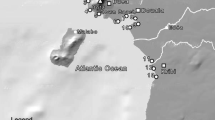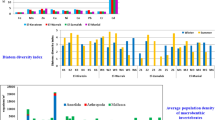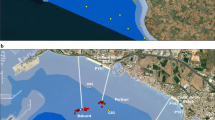Abstract
We measured the concentrations of acid volatile sulfide (AVS), chemical oxygen demand (COD), and metals (As, Cd, Cu, Hg, Pb, and Zn) in surface sediments of 74 intertidal sectors along the western and southern coasts of Korea to determine their spatial distribution and pollution status. The concentrations of AVS, COD, and metals were relatively higher in northwestern and southeastern coasts due to human and industrial activities around metropolitan, industrial complexes, and large-scale farms. The results of the sediment quality guidelines and geoaccumulation index for organic matter and metal revealed that almost all intertidal sediments were unpolluted with regard to AVS, COD, Cd, Cu, Hg, Pb, and Zn and some intertidal sediments in northwestern and southeastern coasts were moderately polluted with regard to As. However, the results of pollution load index and ecological risk index for metal showed that intertidal sediments in the southeastern coast are significantly polluted and could have an adverse effect on benthic organisms. Thus, the appropriate management policy and restoration plan for intertidal sectors with high metal pollution level in Korea is necessary to improve the quality of intertidal sediment.






Similar content being viewed by others
References
Álvarez-Iglesias P, Rubio B (2009) Redox status and heavy metal risk in intertidal sediments in NW Spain as inferred from the degrees of pyritization of iron and trace elements. Mar Pollut Bull 58:542–551
Álvarez-Iglesias P, Quintana B, Rubio B, Pérez-Arlucea M (2007) Sedimentation rates and trace metal input history in intertidal sediments from San Simón Bay (Ría de Vigo, NW Spain) derived from 210Pb and 137 Cs chronology. J Environ Radioact 98:229–250
Beiras R, Fernández N, Bellas J, Besada V, González-Quijano A, Nunes T (2003) Integrative assessment of marine pollution in Galician estuaries using sediment chemistry, mussel bioaccumulation, and embryo-larval toxicity bioassays. Chemosphere 52:1209–1224
Belabed BE, Laffray X, Dhib A, Fertouna-Belakhal M, Turki S, Aleya L (2013) Factors contributing to heavy metal accumulation in sediments and in the intertidal mussel Perna perna in the Gulf of Annaba (Algeria). Mar Pollut Bull 74:477–489
Buchman MF (2008) NOAA screening quick reference tables. NOAA OR&R Report 08–1. Office of response and restoration division, National Oceanic and Atmospheric Administration, Seattle WA, p 34
Çevik F, Göksu MZL, Derici SB, Findik Ö (2009) An assessment of metal pollution in surface sediments of Seyhan dam by using enrichment factor, geoaccumulation index and statistical analyses. Environ Monit Assess 152:309–317
Chakraborty P, Ramteke D, Chakraborty S, Nath BN (2014) Changes in metal contamination levels in estuarine sediments around India—an assessment. Mar Pollut Bull 78:15–25
Chatterjee M, Silva EV, Sarkar SK (2007) Distribution and possible source of trace elements in the sediment cores of a tropical macrotidal estuary and their ecotoxicological significance. Environ Int 33:346–356
Choi KY, Kim SH, Chon HT (2012) Relationship between total concentration and dilute HCl extraction of heavy metals in sediments of harbors and coastal areas in Korea. Environ Geochem Health 34:243–250
Christophoridis C, Dedepsidis D, Fytianos K (2009) Occurrence and distribution of selected heavy metals in the surface sediments of Thermaikos Gulf, N Greece Assessment using pollution indicators. J Hazard Mat 168:1082–1091
Dou Y, Li J, Zhao J, Hu B, Yang S (2013) Distribution, enrichment and source of heavy metals in surface sediments of the eastern Beibu Bay, South China Sea. Mar Pollut Bull 67:137–145
Emmerson RHC, O’Reilly-Wiese SB, Macleod CL, Lester JN (1997) A multivariate assessment of metal distribution in inter-tidal sediments of the Blackwater estuary, UK. Mar Pollut Bull 34:960–968
Feng H, Jiang H, Gao W, Weinstein MP, Zhang Q, Zhang W, Yu L, Yuan D, Tao J (2011) Metal contamination in sediments of the western Bohai Bay and adjacent estuaries, China. J Environ Manag 92:1185–1197
Folk RL (1968) Petrology of sedimentary rock. Hemphill Publishing Co., Austin TX, USA, p 170
Folk RL, Ward WC (1957) Brazos river bar: a study in the significance of grain size parameters. J Sediment Petrol 27:3–26
Gao X, Li P (2012) Concentration and fractionation of trace metals in surface sediments of intertidal Bohai Bay, China. Mar Pollut Bull 64:1529–1536
Gredilla A, de Vallejuelo SF, Arana G, de Diego A, Madariaga JM (2013) Long-term monitoring of metal pollution in sediment from the estuary of the Nerbioi-Ibaizabal River (2005-2010). Estuar Coast Shelf Sci 131:129–139
Hakanson L (1980) An ecological risk index for aquatic pollution control: a sedimentological approach. Water Res 14:975–1001
Hedge LH, Knott NA, Johnston EL (2009) Dredging related metal bioaccumulation in oysters. Mar Pollut Bull 58:832–840
Hwang DW, Kim SG (2011) Evaluation of heavy metal contamination in intertidal surface sediments of coastal islands in the western part of Jeollanam Province using geochemical assessment techniques. Kor J Fish Aquat Sci 44:772–784 (in Korean)
Hwang DW, Jin HG, Kim SS, Kim JD, Park JS, Kim SG (2006) Distribution of organic matters and metallic elements in the surface sediments of Masan Harbor, Korea. J Kor Fish Soc 39:106–117 (in Korean)
Hwang DW, Ryu SO, Kim SG, Choi OI, Kim SS, Koh BS (2010) Geochemical characteristics of intertidal surface sediments along the southwestern coast of Korea. Kor J Fish Aquat Sci 43:146–158 (in Korean)
Hwang DW, Kim SG, Choi M, Lee IS, Kim SS, Choi HG (2016) Monitoring of trace metals in coastal sediments around Korean peninsula. Mar Pollut Bull 102:230–239
Hyun S, Lee T, Choi JS, Choi DL, Woo HJ (2003) Geochemical characteristics and heavy metal pollutions in the surface sediments of Gwangyang and Yeosu Bay, south coast of Korea. Sea – J Korean Soc Oceanogr 8:380–391 (in Korean)
Ingram RL (1971) Sieve analysis. In: Carver RE (ed) Procedures in sedimentary petrology. Willey-Inter Science, New York, pp 49–67
Koh CH, Khim JS (2014) The Korean tidal flat of the Yellow Sea: physical setting, ecosystem and management. Ocean Coast Manag 102:398–414
Laing GD, Meers E, Dewispelaere M, Vandecasteele B, Rinklebe J, Tack FMG, Verloo M (2009) Heavy metal mobility in intertidal sediments of the Scheldt estuary: field monitoring. Sci Total Environ 407:2919–2930
Li Y, Liu H, Zhou H, Ma W, Han Q, Diao X, Xue Q (2015) Concentration distribution and potential health risk of heavy metals in Mactra veneriformis from Bohai Bay, China. Mar Pollut Bull 97:528–534
Lim DI, Choi JW, Shin HH, Jeong DH, Jung HS (2013) Toxicological impact assessment of heavy metal contamination on microbenthic communities in southern coastal sediments of Korea. Mar Pollut Bull 73:362–368
Long ER, MacDonald DD, Smith SL, Calder FD (1995) Incidence of adverse biological effects within ranges of chemical concentrations in marine and estuarine sediments. Environ Manag 19:81–97
Martin CW (1996) Heavy metal concentrations in floodplain surface soils, Lahn River, Germany. Environ Geol 30:119–125
Mashiatullah A, Chaudhary MZ, Ahmad N, Javed T, Ghaffar A (2013) Metal pollution and ecological risk assessment in marine sediments of Karachi coast, Pakistan. Environ Monit Assess 185:1555–1565
MOMAF (2005) Inventory of tidal flats in Korea. Report no. BSPM 29100–1730-3, Seoul, Korea, Ministry of Maritime Affairs and Fisheries, pp 632 (in Korean)
Morelli G, Gasparon M (2014) Metal contamination of estuarine intertidal sediments of Moreton Bay, Australia. Mar Pollut Bull 89:435–443
Müller G (1979) Schwermetalle in den sedimenten des Rheins-Veranderungen seitt. Umschau 79:778–783
Murray NJ, Ma Z, Fuller RA (2015) Tidal flats of the Yellow Sea: a review of ecosystem status and anthropogenic threats. Aust Ecol 40:472–481
NFRDI (2015) Technical report of National Fisheries Research and Development Institute in 2014, report no. TR-2015-PM-002, Busan, Korea, National Fisheries Research and Development Institute, pp 1366 (in Korean)
NORI (2008) Result report for manufacture of tidal flat status map in Korea, report no. 11–1611234–000019-01, Incheon, Korea, National Oceanographic Research Institute, pp 183 (in Korean)
Ra K, Kim ES, Kim KT, Kim JK, Lee JM, Choi JY (2013) Assessment of heavy metal contamination and its ecological risk in the surface sediments along the coast of Korea. J Coast Res 65:105–110
Ryu SO, Chang JH, Lee HJ, Jo YJ, Choi OI (2009) Spatial and temporal variation of surface sediments by tidal environment changes: Muan Bay, west coast of Korea. J Kor Soc Oceanogr 14:10–21 (in Korean)
Saiz-Salinas JI, Ruiz JM, Frances-Zubillaga G (1996) Heavy metal levels in intertidal sediments and biota from the Bidasoa estuary. Mar Pollut Bull 32:69–71
Shah BA, Shah AV, Mistry CB, Navik AJ (2013) Assessment of heavy metals in sediments near Hazira industrial zone at Tapti River estuary, Surat, India. Environ Earth Sci 69:2365–2376
Sheykhi V, Moore F (2013) Evaluation of potentially toxic metals pollution in the sediments of the Kor river, southwest Iran. Environ. Monit Assess 185:3219–3232
Song Y, Choi MS, Lee JY, Jang DJ (2014) Regional background concentrations of heavy metals (Cr, co, Ni, cu, Zn, Pb) in coastal sediments of South Sea of Korea. Sci Total Environ 482-483:80–91
Spencer KL (2002) Spatial variability of metals in the inter-tidal sediments of the Medway estuary, Kent, UK. Mar Pollut Bull 44:933–944
Sun CI, Lee YJ, An JH, Lee YW (2014) Speciation and ecological risk assessment of trace metals in surface sediments of the Masan Bay. Sea - J Korean Soc Oceanogr 19:155–163 (in Korean)
Taylor SR (1964) Abundance of chemical elements in the continental crust: a new table. Geochem Cosmochim Acta 28:1273–1285
Taylor SR, McLennan SM (1995) The geochemical evolution of the continental crust. Rev Geophys 33:241–265
Tomlinson DC, Wilson JG, Harris CR, Jeffrey DW (1980) Problems in the assessment of heavy metals in estuaries and the formation pollution index. Helgo Mar Res 33:566–575
Volvoikar SP, Nayak GN (2015) Impact of industrial effluents on geochemical association of metals within intertidal sediments of a creek. Mar Pollut Bull 99:94–103
Xia P, Meng XW, Yin P, Liu LJ (2008) Heavy metal pollution and its potential ecological risk in the sediments from the Beihai intertidal zone of Guangxi Province. Adv Mar Sci 26:471–477 (in Chinese)
Xu F, Qiu L, Cao Y, Huang J, Liu Z, Tian X, Li A, Yin X (2016) Trace metals in the surface sediments of the intertidal Jiaozhou Bay, China: sources and contamination assessment. Mar Pollut Bull 104:371–378
Yokoyama H (2000) Environmental quality criteria for aquaculture farms in Japanese coastal area—new policy and its potential problems. Bul Natl Res Inst Aquacult 29:123–134 (in Japanese)
Yoon JK, Kim DH, Kim TS, Park JG, Chung IR, Kim JH, Kim H (2009) Evaluation on natural background of the soil heavy metals in Korea. J Soil Groundw Environ 14:32–39 (in Korean)
Yu R, Zhang W, Hu G, Lin C, Yang Q (2016) Heavy metal pollution and Pb isotopic tracing in the intertidal surface sediments of Quanzhou Bay, southeast coast of China. Mar Pollut Bull 105:416–421
Zhang J, Gao X (2015) Heavy metals in surface sediments of the intertidal Laizhou Bay, Bohai Sea, China: distribution, sources and contamination assessment. Mar Pollut Bull 98:320–327
Zhang W, Feng H, Chang J, Qu J, Xie H, Yu L (2009) Heavy metal contamination in surface sediments of Yangtze River intertidal zone: an assessment from different indexes. Environ Pollut 157:1533–1543
Zhu Z, Xue J, Deng Y, Chen L, Liu J (2016) Trace metal contamination in surface sediments of intertidal zone from Qinhuangdao, China, revealed by geochemical and magnetic approaches: distribution, sources, and health risk assessment. Mar Pollut Bull 105:422–429
Acknowledgments
We thank a lot of colleagues who helped with sampling and analyses.
Funding
This work was supported by a research grant from the National Institute of Fisheries Science (R2019045) and by the National Research Foundation (NRF) of Korea (NRF-2019R1C1C1002197).
Author information
Authors and Affiliations
Corresponding author
Additional information
Responsible editor: Severine Le Faucheur
Publisher’s note
Springer Nature remains neutral with regard to jurisdictional claims in published maps and institutional affiliations.
Electronic supplementary material
ESM 1
(DOCX 70 kb)
Rights and permissions
About this article
Cite this article
Hwang, DW., Kim, PJ., Kim, SG. et al. Spatial distribution and pollution assessment of metals in intertidal sediments, Korea. Environ Sci Pollut Res 26, 19379–19388 (2019). https://doi.org/10.1007/s11356-019-05177-z
Received:
Accepted:
Published:
Issue Date:
DOI: https://doi.org/10.1007/s11356-019-05177-z




